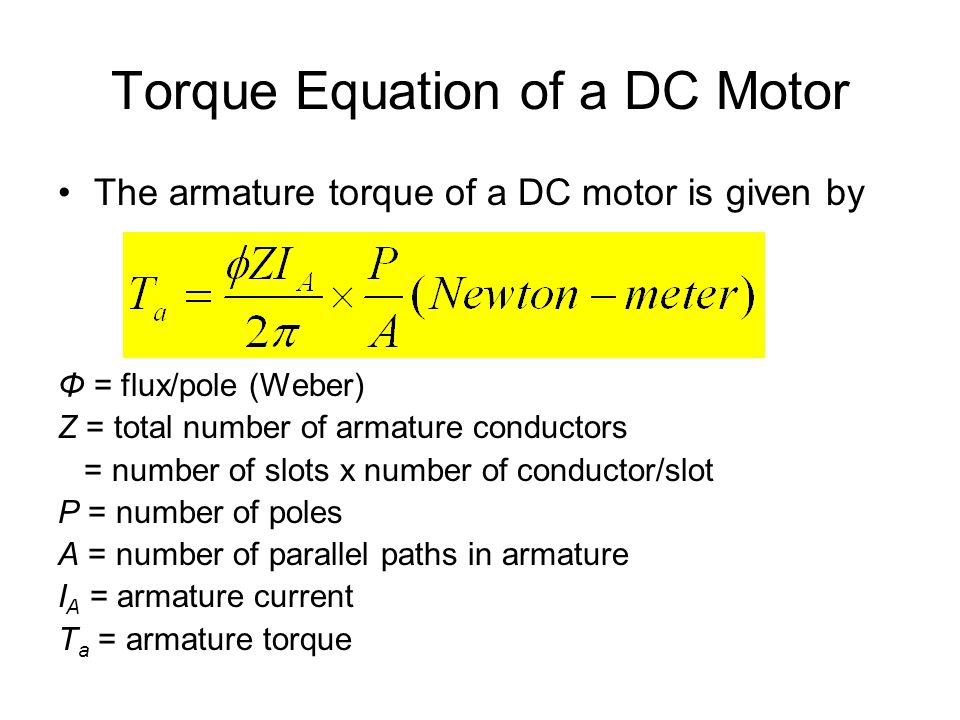For A 5kw Dc Motor The Number Of Slots Per Pole Should Be
- For A 5kw Dc Motor The Number Of Slots Per Pole Should Bet
- For A 5kw Dc Motor The Number Of Slots Per Pole Should Be Lowered
- For A 5kw Dc Motor The Number Of Slots Per Pole Should Be Paid
Number of armature slots in DC machine
A four-pole machine generates 250 volts when operated at 1,500 rpm. If the flux per pole is 1.85 x 10 6 maxwells, the number of armature slots is 45, and the armature winding has two parallel paths, calculate (ɑ) the total number of armature conductors; (b) the number of conductors in each slot. 1 Winding factor harmonics for 4-pole 3-phase integer-slot windings with different number of slots/pole/phase. Example 2: For concentrated windings, the fundamental winding factor increases and decreases as a function of the number of slots/pole/phase as shown in Fig. S is the slot and magnet numbers, which must be even and N r is the rotor pole number. Thus, for a 12-slot machine, any rotor could potentially be chosen, except N r = N s. However, N s and N r should be close to each other to optimize torque density 1,10. However, in order to minimize torque ripple, a sinusoidal back EMF is desirable 11. The ratio of poles to slots changes the 'gearing' of the motor. If you assume that all of the motors are basically the same size, then. When the pole/slot ratio is a lower value 4/12= 1/3, the motor will have a higher KV for the same # of turns around each tooth than a motor with a 6/12 = 1/2 ratio, or a 6/9= 2/3. In a squirrel cage motor, the number of stator slots is rotor slots. Always equal to the number of. Always greater than the number of. Always less than the number of. Either more or less than the number of.
In order to decide what number of slots (more or less) is to be used, the following merits and demerits are considered.
1. As the number of slots increases, cost of punching the slot increases, number of coils increases and hence the cost of the machine increases.
2. As the number of slots increases, slot pitch λs = (slot width bs tooth width bt) = πD/ number of slots S
decreases and hence the tooth width reduces. This makes the tooth mechanically weak, increases the flux density in the tooth and the core loss in the tooth. Therefore efficiency of the machine decreases.
If the slots are less in number, then the cost of punching & number of coils decreases, slot pitch increases, tooth becomes mechanically strong and efficiency increases, quantity of insulation in the slot increases, heat dissipation reduces, temperature increases and hence the efficiency decreases.
For A 5kw Dc Motor The Number Of Slots Per Pole Should Bet
It is clear that not much advantage is gained by the use of either too a less or more number of slots.
As a preliminary value, the number of slots can be selected by considering the slot pitch. The slot pitch can assumed to be between (2.5 and 3.5) cm. (This range is applicable to only to medium capacity machines and it can be more or less for other capacity machines).
The selection of the number of slots must also be based on the type of winding used, quality of commutation, flux pulsation etc.
When the number of slot per pole is a whole number, the number slots embraced by each pole will be the same for all positions of armature. However, the number teeth per pole will not be same.
For A 5kw Dc Motor The Number Of Slots Per Pole Should Be Lowered
This causes a variation in reluctance of the air gap and the flux in the air gap will pulsate. Pulsations of the flux in the air gap produce iron losses in the pole shoe and give rise to magnetic noises. On the other hand, when the slots per pole is equal to a whole number plus half the reluctance of the flux path per pole pair remains constant for all positions of the armature, and there will be no pulsations or oscillations of the flux in the air gap.
To avoid pulsations and oscillations of the flux in the air gap, the number of slots per pole should be a whole number plus half. When this is not possible or advisable for other reasons, the number of slots per pole arc should an integer.
Number of teeth/pole shoe = 5 and flux passes through 5 teeth.

For A 5kw Dc Motor The Number Of Slots Per Pole Should Be Paid
The reluctance of the air gap is inversely proportional to the area corresponding to 5 teeth.